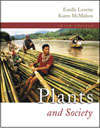
Fungi in the Natural Environment |  |
Chapter Summary1. Fungi are a diverse group of organisms ranging from small, inconspicuous yeasts and molds to large, conspicuous mushrooms, puffballs, and bracket fungi. The majority of fungi consist of a mycelium composed of highly branched hyphae. Fungi reproduce by spores that result from sexual or asexual processes. Fungi have an absorptive type of nutrition, producing enzymes that are secreted into the environment and break down complex organic compounds into smaller molecules. These small molecules are then absorbed by the hyphae.
2. Organisms that have traditionally been called fungi are found in both the Kingdom Protista and the Kingdom Fungi. Slime molds and water molds are included in the Protista, whereas other groups are included in the Kingdom Fungi. The presence of chitin in the cell wall is one of the major distinguishing features. Classification in the Kingdom Fungi is normally based on the method of sexual reproduction, but a large group of organisms are considered asexual fungi, because a sexual stage seldom occurs.
3. The majority of fungi are saprobes, actively recycling nutrients in the environment by decomposing organic matter. Symbiotic relationships among the fungi are well known and both mycorrhizal fungi and lichen fungi play important ecological roles. Other fungi exist as pathogens, obtaining nutrients from a living host.
4. The majority of plant diseases are caused by fungi. Some of these have devastating influences on crop plants and historically some have resulted in major impacts on human society. Rust fungi and smut fungi are especially damaging pathogens on cereal crops, and Dutch elm disease has resulted in the loss of millions of ornamental elm trees throughout North America.
|
|
|